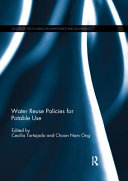
Water Reuse Policies for Potable Use PDF
196 Pages·2018·3.1621 MB·other
Most books are stored in the elastic cloud where traffic is expensive. For this reason, we have a limit on daily download.
Preview Water Reuse Policies for Potable Use
Description:
As water demand has increased globally and resources have become more limited because of physical scarcity, over-exploitation and pollution, it has been necessary to develop more options for water supplies. These options include the production at large scale of high-quality reused water from municipal sources for potable uses. Their economic, social and environmental benefits have been many as they have addressed supply scarcity, efficient resource use and environmental and public health considerations. This book includes discussions on potable water reuse history; emerging contaminants and public health; public-private partnerships in the water reuse sector; regulatory frameworks for reused water in the United States and Europe; experiences in Australia, China in general and Beijing in particular, Singapore and Windhoek; narratives and public acceptance and perceptions of alternative water sources. The main constraints on implementation of water reuse projects in different parts of the world seem to have been lack of full public support due to perceived health hazards and environmental impacts. A main handicap has been that governments and water utilities have been slow to understand public concerns and perceptions. After several backlashes, public information, communication and awareness campaigns, broader participation and educational programmes have become integral parts of development policy and decision-making frameworks.
See more
The list of books you might like
Most books are stored in the elastic cloud where traffic is expensive. For this reason, we have a limit on daily download.
